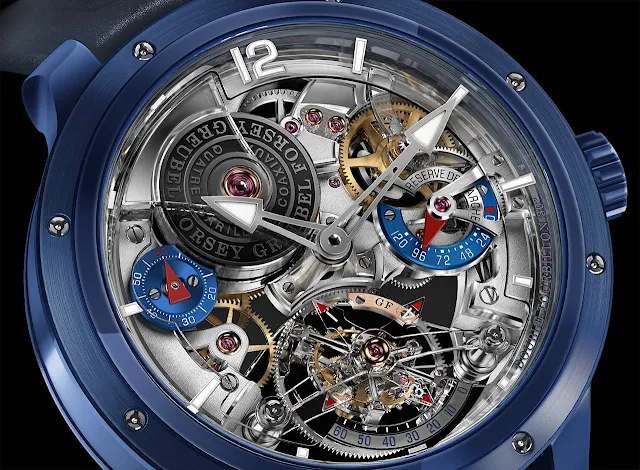The Greubel Forsey Double Tourbillon 30° Technique in blue ceramic comes in a limited edition of 11 timepieces housed in a blue ceramic case. It will be made available to the US market only. The Greubel Forsey Double Tourbillon 30° Technique in Ceramic has a price of US$ 695,000.
The Double Tourbillon 30°, the first Fundamental Invention by Robert Greubel and Stephen Forsey in their quest for ultimate precision, was presented in a timepiece at Baselworld in 2004.
Seven years later, their Double Tourbillon 30° Technique won the first prize at the Concours International de Chronométrie achieving a record score of 915 points out of 1000 with an average timing rate of between 0.3 and 0.8 seconds per day across the whole competition.
The latest interpretation of this exclusive creation comes in a limited edition of 11 timepieces housed in a blue ceramic case. It will be made available to the US market only.
The Greubel Forsey Double Tourbillon 30° Technique in ceramic offers exceptional accuracy thanks to a unique solution: inside a cage which rotates in four minutes, a smaller cage containing the balance and spring assembly is inclined at an angle of 30° relative to the first cage and completes a revolution in 60 seconds. The combination of the 30° inclination with the different rotational speeds of the two tourbillons improves timekeeping by averaging out positional errors due to gravity in all usual wristwatch positions and especially in stable positions.
Four coaxial barrels coupled to a spherical power-reserve differential, provide a chronometric power reserve of 120 hours. The movement beats at a frequency of 3 Hz (21,600 vibrations per hour).
Thanks to the use of sapphire crystal for the bridges, the hour and minute ring as well as the 4-minute tourbillon-rotation indicator at 6 o’clock, the movement architecture can be appreciated in its entirety and from both sides.
The small seconds and power-reserve indicators in gold are finished in blue to present a contrasting effect against the frosted main plates and recall the blue ceramic of the case. The hands are openworked to further enhance the sense of light and transparency.
Machined from single blocks of sapphire, the flanks of the bridges are polished using different grains, requiring highly specialised tools, exceptional precision and expertise. The bevelled angles reveal a matt finish that beautifully contrasts with the polished transparent surfaces of the sapphire.
On the caseback side, the three-dimensional gear train bridge reveals an unobstructed view of the architecture beneath. This unusually large bridge features a multi-level design with countersinks that allow the wheels to precisely imbricate with the sapphire.
The case measures 48.40 mm in diameter and 17.77 mm in height and is made in a deep blue ceramic, a first for Greubel Forsey. This material is compacted by pressing and shaped before firing, where a thermal process shrinks it by around 25%. Once the elements have been sintered at a very high temperature, the ceramic solidifies, making the case extremely hard, as well as extremely resistant to scratches and corrosion, but also more difficult to work with.
Supplied with a blue rubber strap, secured to the wrist by a titanium folding clasp, the Greubel Forsey Double Tourbillon 30° Technique in Ceramic has a price of US$ 695,000. greubelforsey.com
Seven years later, their Double Tourbillon 30° Technique won the first prize at the Concours International de Chronométrie achieving a record score of 915 points out of 1000 with an average timing rate of between 0.3 and 0.8 seconds per day across the whole competition.
The latest interpretation of this exclusive creation comes in a limited edition of 11 timepieces housed in a blue ceramic case. It will be made available to the US market only.
The Greubel Forsey Double Tourbillon 30° Technique in ceramic offers exceptional accuracy thanks to a unique solution: inside a cage which rotates in four minutes, a smaller cage containing the balance and spring assembly is inclined at an angle of 30° relative to the first cage and completes a revolution in 60 seconds. The combination of the 30° inclination with the different rotational speeds of the two tourbillons improves timekeeping by averaging out positional errors due to gravity in all usual wristwatch positions and especially in stable positions.
Four coaxial barrels coupled to a spherical power-reserve differential, provide a chronometric power reserve of 120 hours. The movement beats at a frequency of 3 Hz (21,600 vibrations per hour).
Thanks to the use of sapphire crystal for the bridges, the hour and minute ring as well as the 4-minute tourbillon-rotation indicator at 6 o’clock, the movement architecture can be appreciated in its entirety and from both sides.
Machined from single blocks of sapphire, the flanks of the bridges are polished using different grains, requiring highly specialised tools, exceptional precision and expertise. The bevelled angles reveal a matt finish that beautifully contrasts with the polished transparent surfaces of the sapphire.
On the caseback side, the three-dimensional gear train bridge reveals an unobstructed view of the architecture beneath. This unusually large bridge features a multi-level design with countersinks that allow the wheels to precisely imbricate with the sapphire.
The case measures 48.40 mm in diameter and 17.77 mm in height and is made in a deep blue ceramic, a first for Greubel Forsey. This material is compacted by pressing and shaped before firing, where a thermal process shrinks it by around 25%. Once the elements have been sintered at a very high temperature, the ceramic solidifies, making the case extremely hard, as well as extremely resistant to scratches and corrosion, but also more difficult to work with.
Supplied with a blue rubber strap, secured to the wrist by a titanium folding clasp, the Greubel Forsey Double Tourbillon 30° Technique in Ceramic has a price of US$ 695,000. greubelforsey.com















Simply spectacular. I am wordless.
ReplyDelete